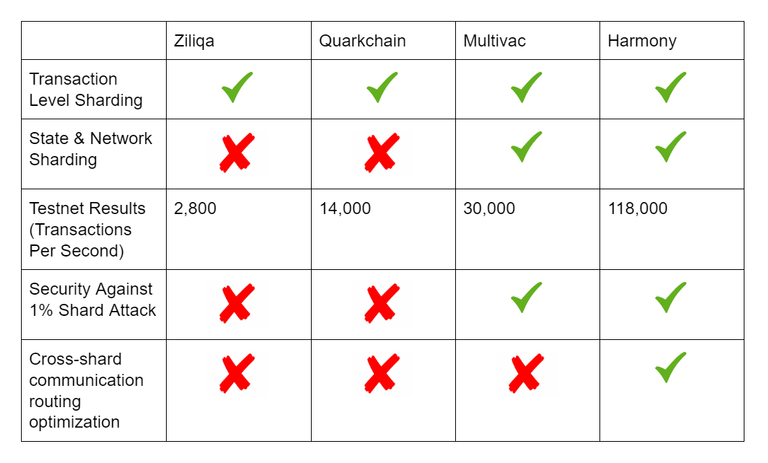INTRODUCTION: BLOCKCHAIN TECHNOLOGY AND CHALLENGES BEING FACED

The creation of blockchain technology in 2008 that along with it, brought a whole new realms of possibilities. However, progress was slow, and the industry was struggling to find its footing. This lead to the creation of the Ethereum blockchain that looked to answer some of the questions that were left unanswered.
Indeed, possibilities and application were stretched, but still being inadequate, solutions like IOTA came on board to try to handle issues related to sequential processing of transactions. However, this ensured that compromises had to be made with regards to security and decentralisation-which are core features of the blockchain industry.
HARMONY: WHAT’S THE FUSS?
Harmony is a fully scalable, provably secure sharding based blockchain. It is also energy efficient, and takes into cognisance the challenges its predecessors faced. This knowledge is being used to ensure that its system is optimally tuned. It makes use of distributed randomness generation, which ensures that its system is not biased, and is also unpredictable, scalable, and verifiable.
Other features of Harmony:
Efficient and Fast Consensus: Makes use of Proof of Stake. Uses a linearly scalable BFT algorithm that is a hundred times more faster than PBFT (Practical Byzantine Fault Tolerance).
Adaptive-Thresholded PoS: Prevents malicious stakers from being able to hijack the system. Small players are able to still benefit from the system.
Scalable Networking Infrastructure: Making use of RaptorQ fountain code ensures that Harmony can propagate blocks quickly within shards or across network by employing the Adaptive Information Dispersal Algorithm.
Consistent Cross-Shard Transactions: Communication between shards is direct.
Harmony ensures that the use of blockchain technology can be extended, and applications that weren’t possible, such as interactive fair games, high scale payment systems, IoT transactions and high volume on-chain exchanges can exist, meeting the needs of billions of people.
CONSENSUS MECHANISM
Consensus Protocol is extremely important, because it is responsible for determining when blockchain validators reach consensus on the next block, and also how securely this is achieved.
Bitcoin makes use of a PoW consensus. This basically assumes that at the very least, a greater portion of hashing power is controlled by honest nodes.
With regards to PBFT, one node is positioned as the lead, while others are “validators”. Here, the lead broadcasts its proposal to the validators who share it with every other person, in order for votes to be noted. It also involves a commit phase.
On Harmony, rather than broadcasting votes, the lead deploys a multi-signature signing process to collect all votes. Rather than receiving votes, validators receive just one multi-signature. This saves time, energy and shortens the communication trail. This consensus protocol is known as Fast Byzantine Fault Tolerance (FBFT).

SHARDING
Since the last quarter of 2017, several sharding technologies have been proposed. Ziliqa set the pace by delivering a throughput of 2800tps. Other solutions like Omniledger and RapidChain have worked on solutions that make use of state sharding, ensuring that each shards holds a subset of the state of the blockchain.
Following the progress made by these solutions, Harmony took it a step further, and designed a POS-based full sharding scheme. It has a beacon chain and multiple shard chains.
DISTRIBUTED RANDOMNESS GENERATION
This has been recognised as the most secure solution among sharding solutions. Here, a random number agreed to by parties involved, is used in determining sharding assignments for each node. Random numbers must be unpredictable, unbiasebale, verifiable, and scalable.
EPOCHS
The concept of Epochs is used in handling the consensus and sharding process.
STAKING-BASED SHARDING
Validator Registration
To become Validators on Harmony, those that are interested will have to stake a set amount of tokens to be considered. The number in question will be determined by number of voting shares assigned to the Validator. One voting share is equal to one consensus vote.

Voting Shares
Voting shares ensure that users can cast one single vote each, in a consensus. Preventing large-stake attacks is done by making use of sharding by voting shares. Validators with bigger stakes stand a higher chance of being selected as the “Leader”.
RESHARDING
When a shard remains static, malicious attacks can still occur by the validators in that shard being corrupted. Types of attacks that exist are static round adaptive, slowly adaptive and fully adaptive. To fight this, Harmony makes use of the Cuckoo-rule based resharding mechanism. Withdrawing ones stake before the end of an epoch guarantees eviction.
FAST-STATE SYNCHRONISATION
Joining a new shard ensures that validators are brought up to speed with the state of that shard via synchronisation. Downloading the blockchain history and reconstructing is archaic. Current state download within the time window is much more attainable.
SHARD CHAIN AND BEACON CHAIN
Shard chains are blockchain’s that have the ability to process and validate their transactions, while storing its state. Shard chains are independent to a great degree, but they also carry out cross-chain communication via cross-shard communication. cross-shard communication ensures that capabilities can be extended.
Beacon chains are also shards, however they go a step further by being responsible for the random number generated and accepting stakes from validators.
BLOCKCHAIN STATE SHARDING
On Harmony, each shard has its own account state, while all tokens are spread across shards. User accounts and smart contract accounts are handled separately, as regards sharding.
NETWORKING
To ensure that network failure is not prevalent, efficiency of network utilisation is a primary focus of Harmony.
INCENTIVE MODEL
Harmony ensures that rewards for validators that signed the block are rewarded via tokens that are commensurate to their voting shares.
When it is determined that foul play occurred, some tokens will be deducted from the amount to be allocated. Validators are encouraged to expose cheats. When such has been proven to be true, deducted tokens will be given to them. These are some of the factors that make Harmony a much better solution than the competition.
USE CASE
Solos is an interactive virtual gaming world that has games ranging from competing as teams from different corners of the globe, to massive hunt games, where every player has to vanquish hundreds of players, to be crowned the undisputed champ. Before Harmony, they had had users complaining about malicious attacks. Others experienced downtime at peak periods, and some could not even connect, after investing mentally and financially to be part of contests.
The team knew that they were not performing efficiently, and this was a headache, seeing they wanted their platform to run on decentralised channels. Numbers were dropping fast, until they had a test-run on Harmony. Now they have a sense of stability, and are glad they can simply focus on creating a community their users deserve.

SUMMARY
By making use of Harmony, teams will not need to sacrifice one important feature for another. Example security for flexibility. Teams are able to build their projects on a solid foundation that is unpredictable and highly scalable. Knowing that features are put in place to remove unfairness and malicious attacks, teams are able to focus purely on building their products.
Studying what worked and why they worked as well as what the shortcomings of their predecessors were ensures that Harmony is able to build something that will be much more robust and effective in meeting the needs of the world’s diverse population.
Continuing to set the bar high, and reinventing the wheel where necessary ensures that blockchain technology will grow, and value can be transferred in multiple forms, thanks to the shift put in by the Harmony team.
For more information, kindly visit:
https://harmony.one/